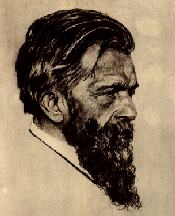150 Years of the Austrian School of Economics
By Caleb Fuller


Both treatises offered a (similar) solution to the famous “value paradox”: Why are diamonds, a frippery, so expensive compared to water, something essential to sustaining life? Some version of this question had stumped luminaries such as Plato, Thomas Aquinas, Copernicus, John Locke, Adam Smith, and Benjamin Franklin, to name but a few. When Menger, Jevons, (and a few years later) Leon Walras provided an answer based on the relative scarcity of diamonds to water, they changed economics forever. Only Newton and Leibniz’s near-simultaneous discovery of calculus rivals these three thinkers’ serendipitous breakthrough.
Menger’s star rose quickly thereafter as students flocked from all over Europe to study with him. The so-called “Austrian School” of economics was emerging.
An Enduring Legacy
Fifteen decades after Menger’s seminal work, the Austrian tradition in economics survives as a vibrant community of scientific discourse. As was true only a few years after Menger’s 1871 publication, this community is currently characterized by sometimes-complementary, sometimes-rivalrous “sub-traditions”—a requisite mark of a progressive research program. Yet, all the identifiable traditions within the contemporary Austrian School have tended to emphasize several analytical propositions derived from the foundational idea that the “sciences of man” should employ different methods than the “natural sciences” (a position known as “methodological dualism”).
Contrary to the views of some lay commentators, academic Austrian economics is distinct from any ideological position—whether left or right—as well as recent populist movements, which have often appropriated the label. Instead, it is a body of analytical work aimed at interpreting and understanding the social world. And while not always occupying the center-stage of social scientific thought, it would be a mistake to characterize the Austrian tradition as a “backwater” intellectual movement.
Though a close intellectual cousin of what might now be called “mainstream” or “Neoclassical” economics, the Austrian School survives as a distinct intellectual tradition due to the explanatory power of its ideas and a series of social-historical events, which have repeatedly vindicated the Austrian perspective. I mention the most notable below.
The Refutation of Theoretical Marxism
Today, very few economists explicitly identify as Marxist [see Karl Marx]. This is largely attributable to the work of Menger’s greatest student, Eugen von Böhm-Bawerk. By the turn of the 20th century, Böhm-Bawerk was one of the world’s most recognizable living economists. His fame derived in part from his devastating critique of the Marxian paradigm.1 Among other technical contributions, Böhm-Bawerk showed that employees’ wages are discounted because they are paid in advance of the revenue they generate. If laborers were willing to be paid at the time of sale, their wages would rise—but it would also force them to go without income for a possibly extended period. After Böhm-Bawerk, most economists found Marx’s labor theory of value and exploitation to be indefensible. The full-orbed explanation for why socialism in practice fails, however, was left to Böhm-Bawerk’s most insightful student: Ludwig von Mises.
The Great Depression
Third generation Austrian Mises, like Böhm-Bawerk, rose to international prominence, eventually becoming a Distinguished Fellow of the American Economic Association. Indeed, MIT economist Paul Samuelson—not someone who could be mistaken for an Austrian—argued that Mises would have been honored with a Nobel Prize in Economics had the prize been awarded in earlier years. What made Mises’ renown more impressive was that he achieved it despite being displaced from his native Austria by the Nazis. He subsequently settled in New York City, where he was forced to speak and write something other than one of the four European languages he knew.
According to Ben Bernanke, understanding the causes of the Great Depression is “the holy grail of macroeconomics.”2 Yet, in 1912, seventeen years before the infamous 1929 downturn, Mises published his Theory of Money and Credit, which offered a theory of depressions that matched the contours of the actual Great Depression. Briefly, Mises argued that artificial credit creation spurs investments that are later revealed as unprofitable. On this view, the Roaring 20’s was a manifestation of a credit-fueled boom, which resulted in an inevitable bust. Arguably, the theory is now the most distinguishing feature of the contemporary Austrian School. In 1974, Mises’ student, F.A. Hayek, was awarded the Nobel Prize in Economics for his extensions of Mises’ theory.
Socialism and the Collapse of Communism
If he had contributed nothing else, Mises’ fame would have been solidified based on his analysis of socialism. In 1920, Mises staked out his position on the impossibility of socialism, an argument he continued to refine up through the publication of his 1949 magnum opus, Human Action. Like many of the “greatest hits” in economics, Mises’ argument is disarmingly simple (though far from simplistic). Socialism eliminates markets for factors of production (land, labor, and capital goods). Without markets for factors, there are no money prices for them. Without money prices, there is no profit and loss. And without profit and loss, it is impossible to determine what to produce or how to produce it.
While Mises (and subsequently his students, F.A. Hayek and Murray Rothbard) developed and extended this argument, leading economic lights, such as Paul Samuelson, insisted (through 1989!) that central planning would prove superior to unhampered markets. Shortly after Samuelson’s triumphalist pronouncements, the events of the late 20th century brought vindication to the Austrian position. Leading socialist thinker Robert Heilbroner concluded in 1989 that: “The Soviet Union, China, and Eastern Europe have given us the clearest possible proof that capitalism organizes the material affairs of mankind more satisfactorily than socialism.”3
The Underdeveloped World
During the Socialist Calculation Debate, Mises, Hayek, Rothbard, and other Austrians explained the failure of central planning on the one hand and the primacy of private property rights for economic development on the other. Those important lessons were soon to find a new stage on which to be proven true.
The post-World War II era saw the rise of large supranational organizations, like the International Monetary Fund and the World Bank, which sought to remake the Third World in the image of the West. Central to these organizations’ strategies was the funneling of aid dollars to the least developed countries to plan their societies top-down. Austrians saw little analytical difference between this initiative and the attempt to centrally plan the Soviet economy. Several trillion aid dollars later, the Austrian perspective has been vindicated.4
Despite meddling by Western governments, the second half of the 20th century also one saw the retreat of predation by many local governments worldwide. As the Austrians had argued, private property gives rise to profit and loss, which allows for producers to evaluate the consequences of their investment decisions. Private property rights also provide the incentive for entrepreneurs to undertake investment in the first place. In the second half of the 20th century, private property rights became stronger around the world. The anticipated growth quickly followed. Between 2005 and 2015, the number of people living on more than ten dollars a day grew by 900 million.
The 2008 Financial Crisis
Like the Great Depression, the 2008 Financial Crisis was precipitated by a wave of “easy money” fueled by the world’s central banks. The pattern of boom followed by bust and sluggish recovery fit the pattern predicted by the Austrian business cycle theory like a glove. In the years prior to the crisis, some Austrians had warned that central bank policy was sowing the seeds of a significant downturn.
Today
In the 20th century, students and “grand-students” of Carl Menger held academic posts at the University of Chicago, the London School of Economics, NYU, Princeton, and Johns Hopkins. Whereas the Austrians of yesteryear illuminated many of the most policy-relevant debates of the 20th century, a new generation is applying the Austrian analytical lens to pressing 21st century issues. These include the study of war, economic development, entrepreneurship, private governance, paternalism, monetary policy, and much more. Judging by the output of today’s Austrians, Menger’s animating vision is alive and well. Here’s to another 150 productive and insightful years of the Austrian School.
Footnotes
[1] Eugen von Böhm-Bawerk, Karl Marx and the close of his system, a criticism. Online Library of Liberty.
[2] Ben S. Bernanke, “The Macroeconomics of the Great Depression: A Comparative Approach,” Journal of Money, Credit, and Banking. Volume 27, Number 1, February 1995.
[3] Robert Heilbroner, “The Triumph of Capitalism,” The New Yorker. January 15, 1989.
[4] William Easterly and Tobias Pfutze, “Where Does the Money Go? Best and Worst Practices in Foreign Aid,” Journal of Economic Perspectives. Volume 22, Number 2, Spring 2008.
* Caleb Fuller is an assistant professor of economics at Grove City College and a faculty affiliate at the Program on Economics and Privacy.
